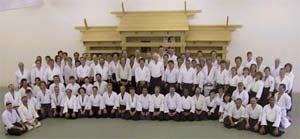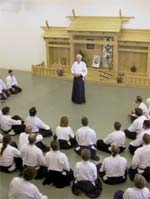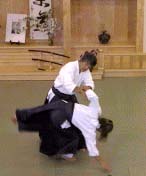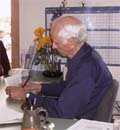vol 5, June 2000

Boulder Aikikai Spring Seminar
April 27-30, 2000
Contributed by Rick Renner
Boulder Aikikai's Annual Spring Seminar, held during the last weekend of April, was a great success - as both a good training session and a literary event. We had the honor and pleasure of having George Leonard sensei of Aikido of Tamalpais, along with Hiroshi Ikeda sensei of Boulder Aikikai, as instructors for the eight-session seminar. Leonard sensei is not only an accomplished aikidoka and instructor, but also a gifted writer. Leonard sensei, formerly the editor of Look Magazine in the 1950s and '60s and a contributing editor to Esquire, has written 12 books, ranging from cultural/historical works to studies of athletes and aikido. Following the Saturday afternoon keiko, Leonard sensei signed copies of his books Mastery (1992) and The Way of Aikido (1999).

The seminar was an enjoyable blend of spirited technical training interspersed with inspiring stories about aikido on and off the mat. The keiko sessions began on Thursday night, and were taught alternately by sensei Leonard and Ikeda. Ikeda sensei opened the seminar by extending a warm welcome to Leonard sensei, and then started with a class on basic techniques - kokyunage and ikkyo. Ikeda sensei used powerful and sometimes minute movements of the arms, wrist and hips to show us how to use our centers to move uke.
 Leonard sensei began his first session with a demonstration of the power of relaxation and fluid movement. He did this by walking "into and through" uke, using a basic kokyunage technique. Leonard sensei discussed the importance of good posture and attitude, and noted that in a study conducted at Rahway State Prison, inmates were asked to choose people from videos whom they would attack or mug. The "victims" were not necessarily the smallest or oldest, but those who did not walk in an open, relaxed, confident manner. In other words, how we walk and carry ourselves has an effect on our ability to protect ourselves. Leonard sensei continued this exercise several times throughout the seminar, emphasizing the importance of a relaxed upper body and a controlled center.
Leonard sensei began his first session with a demonstration of the power of relaxation and fluid movement. He did this by walking "into and through" uke, using a basic kokyunage technique. Leonard sensei discussed the importance of good posture and attitude, and noted that in a study conducted at Rahway State Prison, inmates were asked to choose people from videos whom they would attack or mug. The "victims" were not necessarily the smallest or oldest, but those who did not walk in an open, relaxed, confident manner. In other words, how we walk and carry ourselves has an effect on our ability to protect ourselves. Leonard sensei continued this exercise several times throughout the seminar, emphasizing the importance of a relaxed upper body and a controlled center.
On Friday, the first full day of training, Leonard sensei continued the theme of being centered and relaxed, demonstrating in multiple ways that relaxation - unencumbered mind and non-tensed body - is a powerful tool. Demonstrating katatedori nikkyo, Sensei continued using the principle of relaxation, and introduced the concept of visualization. While turning his wrist outside of uke's hold and locking uke's hand, Sensei discussed extending "long fingers" through the neck of uke, rather than simply pushing downward. In the visualization, nage also extends his center throughout the length of uke's body, and does not limit his power to the strength of the wrist. Throughout his classes, Leonard sensei shared short personal stories with marvelous insights relating to aikido and the lessons at hand.
 Saturday's sessions began with Ikeda sensei showing how to use the arms as extensions of center only - in providing direction, but not power. Small rotations and twists of the wrists can be used to help take uke's balance, though the real power comes from the hips and center.
Saturday's sessions began with Ikeda sensei showing how to use the arms as extensions of center only - in providing direction, but not power. Small rotations and twists of the wrists can be used to help take uke's balance, though the real power comes from the hips and center.
Leonard sensei continued in the afternoon with larger circular movements, including what he termed the "corkscrew" effect, by continuing to rotate uke into a joint control or pin after a kotegaish throw. At the conclusion of this class, Sensei demonstrated an energy exercise, followed by a story. The exercise consisted of standing with one's arms down and slightly out to the sides and having a partner attack unexpectedly from behind, forcefully grabbing the wrists and yelling loudly. Sensei discussed how such a shock to the system - or any shock, such as bad news, confrontation, etc. - creates energy in one's body. There are four possible reactions: fight it; succumb to it; deny it; or most powerful - acknowledge the shock and the energy created and experience it fully. This allows one to use the energy for good purpose. The story Sensei told, which is recounted in full in his book, The Way of Aikido, made his point. In a potentially highly confrontational radio interview in New York some years ago, Sensei acknowledged the negative energy of a hostile interviewer, blended with it and with the interviewer, and turned the whole affair into a positive event, leaving the hostile interviewer neutralized and somewhat perplexed. Easier said than done, of course, but the concept is relevant to aikido and to everyday life. If we can acknowledge such energy - whether it be from emotion or a physical attack - and accept it graciously, we can harness it and use it as a resource.
 We all enjoyed a dinner and party on Saturday evening and on Sunday morning each sensei taught a final class, as the seminar drew to a close. The seminar ended with an eagerly awaited book signing session, during which students had the opportunity to visit with Leonard sensei. The students of Boulder Aikikai wish to thank both George Leonard sensei and Hiroshi Ikeda sensei for their wonderful gift of teaching.
We all enjoyed a dinner and party on Saturday evening and on Sunday morning each sensei taught a final class, as the seminar drew to a close. The seminar ended with an eagerly awaited book signing session, during which students had the opportunity to visit with Leonard sensei. The students of Boulder Aikikai wish to thank both George Leonard sensei and Hiroshi Ikeda sensei for their wonderful gift of teaching.
Rick Renner is a student at Boulder Aikikai in Boulder, Colorado, USA.



